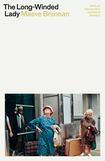
Between 1954 and 1981, Maeve Brennan wrote for the Talk of the Town feature in the New Yorker, under the pseudonym The Long-Winded Lady. An anthology of 47 pieces was first published in 1969 with a foreword by the author, and since then various new editions have appeared – in 2017 from Stinging Fly, introduced by Belinda McKeon. This latest edition includes nine extra pieces, plus a deeply thoughtful introduction by Sinéad Gleeson.
The Long-Winded Lady is a roving camera. She brings us along Fifth Avenue or 46th Street or Broadway, up the elevator (she doesn’t like elevators much) of innumerable hotels, on the Number 5 bus, and into many restaurants – she lives in hotels and always eats out. The waiters know her, she knows some regular customers, but she seldom reports her own conversations, rather eavesdropping on others. She does not hide herself from the reader – she tells us where she lives, what she’s reading, where – although seldom what – she eats. But deeper personal feelings are implied rather than expressed. A Shoe Story is an exception:
“I began to listen to the conversation of two ladies who were sitting near me looking at evening sandals. They were talking about the election. They were talking about Senator John Fitzgerald Kennedy. One of them said, ‘He’s simply too young. He’s too young.’
The other one said, ‘Much too young.’
The first one said, ‘Forty-three years old. It’s absurd.’
I began to feel very cheerful. I am forty-three.”
This is probably in line with the sparkly sophisticated fly-on-the-wall style most Talk of the Town writers used – she necessarily employs a technique of objective description – which is different from the intimacy of her short stories, where she gets inside the heads and hearts of the characters.
“He was very slim, and she walked like two snakes, while her hemline slithered about her knees. She was much too clever to wear a very short dress. She showed her knees, and left the rest to her audience, to us – to all of us.”
Exactly! In her rich evocative prose, Maeve Brennan shows what she observes and leaves the rest up to us. An amusing, sensitive guide, she leads us around Manhattan in the 1950s and 1960s, hinting at, rather than revealing, the spirit of her New York. It’s good fun and quite a privilege.
Éilís Ní Dhuibhne’s latest books are (Selected Stories, Blackstaff) and Fáinne Geal an Lae (Cló Iar Chonacht)













